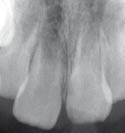(b) 
Table 7.3.1 Clinical and radiographic signs of intrusion injuries
| Clinical features of intrusion injuries | |
|
|
| Radiographic features of intrusion injuries | |
|
|
Given the nature of the injury, no sensibility tests were performed. A radiograph (Figure 7.3.1b) of the maxillary incisor region revealed erupting lateral and central incisor teeth. The 21 was positioned more apical to the adjacent the 11. All the incisors were at a very early stage of development, commensurate with the patient’s age. There were no signs of any root fractures.
Diagnosis and treatment planning
The diagnosis was intrusive luxation of the 21. The treatment plan was to monitor the intruded tooth for spontaneous re-eruption.
Do all traumatically intruded teeth spontaneously re-erupt?
Intruded teeth have the potential for spontaneous re-eruption in patients up to the age of 17 years. This is the desired outcome, although it is not always predictable (Table 7.3.2).
Table 7.3.2 Treatment protocols for luxation injuries
| Intrusive luxation ’ treatment of teeth with incomplete root formation (up to the age of 15 years) | |
|
|
| Intrusive luxation ’ treatment of teeth with complete root formation (after the age of 15 years) | |
|
|
How often should the patient be reviewed?
It is important to monitor the response to the injury with periodic review visits. The first follow-up should be at about 2 weeks, and then the tooth should be reviewed at 2–3, 6 and 12 months and annually thereafter, for at least 5 years.
What is considered to be the most desirable outcome?
Stay updated, free dental videos. Join our Telegram channel

VIDEdental - Online dental courses


